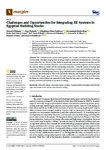Challenges and Opportunities for Integrating RE Systems in Egyptian Building Stocks
| dc.contributor.author | Elshamy, AI | |
| dc.contributor.author | Elshazly, E | |
| dc.contributor.author | Oladinrin, Olugbenga Timo | |
| dc.contributor.author | Rana, MQ | |
| dc.contributor.author | Abd el-Lateef, RS | |
| dc.contributor.author | El-Badry, ST | |
| dc.contributor.author | Elthakaby, M | |
| dc.contributor.author | Elbaz, AMR | |
| dc.contributor.author | Dewidar, K | |
| dc.contributor.author | El-Mahallawi, I | |
| dc.date.accessioned | 2023-01-23T12:10:37Z | |
| dc.date.available | 2023-01-23T12:10:37Z | |
| dc.date.issued | 2022-11-28 | |
| dc.identifier.issn | 1996-1073 | |
| dc.identifier.issn | 1996-1073 | |
| dc.identifier.other | ARTN 8988 | |
| dc.identifier.uri | http://hdl.handle.net/10026.1/20193 | |
| dc.description.abstract |
<jats:p>The twentieth century started with engineers’ new concepts and ideas to develop the built environment, with ideas ranging from reducing weight to automated industrialisation, enhancing energy efficiency, etc. However, they failed to predict the negative impact of automation on the environment and its resources. Therefore, future technologies proposed by engineers should consider the adverse effects on nature and the surrounding ecosystem. Using the science of ecology and integrating it into building typology can help avoid unwanted scenarios. Such technologies prioritise the performance of buildings and cities by using simulation tools to explore more ideas for designing and testing their performance. This work explores the obstacles and challenges opposing the plan to successfully supply Egypt with clean, renewable energy that reaches 42% of its total electricity. Furthermore, some solutions are proposed to tackle those barriers, such as installing thermal cooling systems and ball wind turbines in residential buildings.</jats:p> | |
| dc.format.extent | 8988-8988 | |
| dc.language | en | |
| dc.language.iso | en | |
| dc.publisher | MDPI AG | |
| dc.subject | renewable energy | |
| dc.subject | renewable energy systems | |
| dc.subject | Egyptian built environment | |
| dc.subject | green buildings | |
| dc.subject | small-scale wind turbines | |
| dc.subject | solar-thermal cooling | |
| dc.title | Challenges and Opportunities for Integrating RE Systems in Egyptian Building Stocks | |
| dc.type | journal-article | |
| dc.type | Journal Article | |
| plymouth.author-url | https://www.webofscience.com/api/gateway?GWVersion=2&SrcApp=PARTNER_APP&SrcAuth=LinksAMR&KeyUT=WOS:000896786800001&DestLinkType=FullRecord&DestApp=ALL_WOS&UsrCustomerID=11bb513d99f797142bcfeffcc58ea008 | |
| plymouth.issue | 23 | |
| plymouth.volume | 15 | |
| plymouth.publication-status | Published online | |
| plymouth.journal | Energies | |
| dc.identifier.doi | 10.3390/en15238988 | |
| plymouth.organisational-group | /Plymouth | |
| plymouth.organisational-group | /Plymouth/Faculty of Arts, Humanities and Business | |
| plymouth.organisational-group | /Plymouth/Faculty of Arts, Humanities and Business/School of Art, Design and Architecture | |
| plymouth.organisational-group | /Plymouth/Users by role | |
| plymouth.organisational-group | /Plymouth/Users by role/Academics | |
| dcterms.dateAccepted | 2022-11-24 | |
| dc.rights.embargodate | 2023-1-24 | |
| dc.identifier.eissn | 1996-1073 | |
| dc.rights.embargoperiod | Not known | |
| rioxxterms.versionofrecord | 10.3390/en15238988 | |
| rioxxterms.licenseref.uri | http://www.rioxx.net/licenses/all-rights-reserved | |
| rioxxterms.type | Journal Article/Review |


